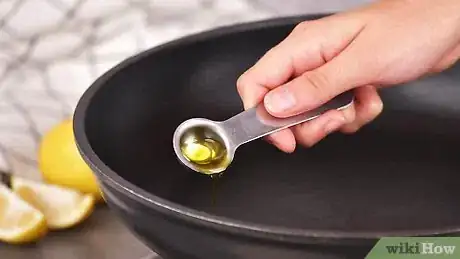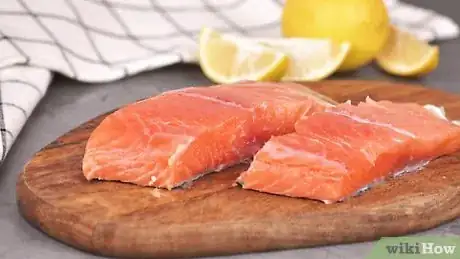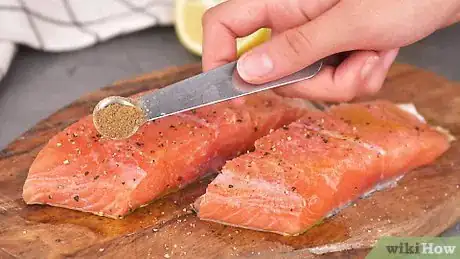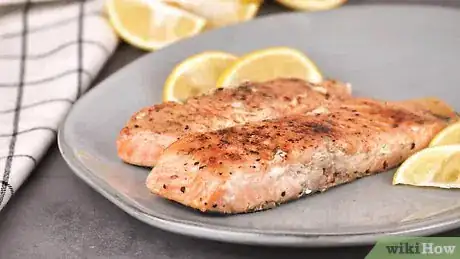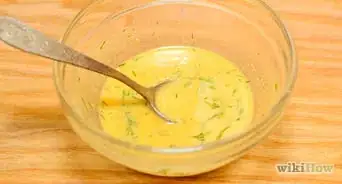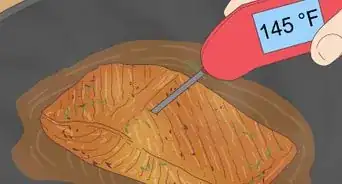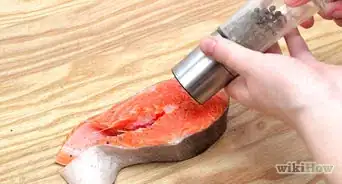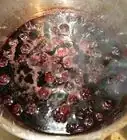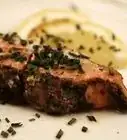This article was co-authored by wikiHow staff writer, Jessica Gibson. Jessica Gibson is a Writer and Editor who's been with wikiHow since 2014. After completing a year of art studies at the Emily Carr University in Vancouver, she graduated from Columbia College with a BA in History. Jessica also completed an MA in History from The University of Oregon in 2013.
The wikiHow Culinary Team also followed the article's instructions and verified that they work.
This article has been viewed 134,461 times.
Learn more...
Cooking an entire salmon can be intimidating for most home cooks. Fortunately, salmon fillets cook up easily on the stove top. You can season the salmon however you like and simply pan fry them. Pan frying salmon creates a crisp skin while keeping the flesh moist. Try pan frying salmon and you'll have a flavorful meal ready in minutes!
Ingredients
- 1 teaspoon of olive oil, for heating the pan
- 2 6-ounce salmon fillets
- 2 teaspoons of olive oil, for drizzling over the salmon
- 1/4 teaspoon of kosher salt
- A few grinds of fresh cracked pepper
Steps
Seasoning the Salmon
-
1Heat your pan. Place a 10 to 12-inch saute pan or skillet over medium heat. Drizzle a teaspoon of olive oil in the pan. The oil can keep the salmon from sticking. Heat your pan till you feel warmth coming off of the pan when you hold your hand about 4 inches above it.
- Choose a non-stick skillet or cast iron skillet. These can prevent the salmon skin from sticking to the pan.
-
2Cut your salmon, if needed. Your salmon should be cut into fillets of about 2 inches wide. If you bought a long fillet of salmon, carefully use a sharp knife to cut the salmon into individual fillets. For this recipe, you'll need two fillets that weigh about 6 ounces each. Remove any pin bones from the salmon fillets before you cook them.[1]
- To remove the bones, feel the sides of the fillets for any sharp or prickly bones sticking out. Use needle-nosed pliers to pull the thin bones out of the fillets.
Advertisement -
3Oil and season your salmon. Pat the salmon dry with paper towels to remove moisture. Drizzle the flesh of the salmon with 2 teaspoons of olive oil. Try to drizzle the oil evenly so both fillets are lightly covered with the oil. Sprinkle 1/4 teaspoon of kosher salt over the fillets and grind a few twists of black pepper over them.[2]
- The oil will help the flesh of the salmon brown as it cooks and prevent sticking.
-
4Try a different seasoning. Use your favorite spices or seasonings to add extra flavor. If you don't want much additional flavoring (beyond the salt and pepper), but want extra color in your salmon fillets, sprinkle paprika over them. This will help make a reddish-brown color as they cook. For unique seasonings, try:[3]
- A dry barbecue rub
- Chinese 5-spice
- Garam Masala
- Ras el Hanout
Cooking the Salmon
-
1Place your salmon in the pan. If you want crispier skin, place the salmon skin-side down. If you're not planning on serving the skin with the fillet, place it flesh-side down.[4] You should leave the skin on while cooking since it's easier to remove after it's cooked and it can help prevent overcooking the salmon.[5]
- If you decide to make more than two fillets, make sure not to crowd the pan since this can lower the temperature of the pan. Instead, just pan fry them in batches.
-
2Flatten the salmon with a fish spatula. The salmon will probably begin curling in towards itself during the first minute or two of cooking, especially if you placed it skin-down. To keep the fillet flat as it cooks, press down evenly using a fish spatula.[6]
- A fish spatula is a narrow metal spatula that gets wider at the end. It's flexible but strong enough to lift up a delicate fillet in one piece.[7]
-
3Pan fry your salmon. Salmon fillets that are 6 to 8 ounces in weight will need to cook for a total of about 4 minutes. If you have thin fillets, cook each wide side for 2 minutes. If your fillets are pretty thick on one end and taper to thin on the other end, consider pan frying the large wide sides for 1 1/2 minutes each and 30 seconds on each narrow small side.[8]
- It's a good idea to use a timer to cook your fillets. Thermometers can be inaccurate since the shape and size of the fillets varies and cooks at different speeds.
- Avoid flipping the salmon repeatedly. This will prevent a good crust from developing.[9]
-
4Let the salmon rest. Remove the salmon to plates and cover the fillets with a large piece of aluminum foil. Let the salmon rest for about 5 minutes. This gives the fish a chance to finish cooking and the juices will redistribute within the fillets. Serve the salmon while it's still warm.
- You can cook the salmon ahead of time and refrigerate it. Use this in recipes that call for cooked, flaked salmon. Be aware that the skin will lose its crispness, so you should probably remove it before serving it.
Things You'll Need
- Saute pan or cast iron skillet
- Needle-nosed pliers, optional
- Metal fish spatula
- Timer
- Serving plate
- Aluminum foil
References
- ↑ https://www.foodnetwork.com/videos/pan-seared-salmon-0136160
- ↑ https://www.foodnetwork.com/videos/pan-seared-salmon-0136160
- ↑ https://www.thekitchn.com/recipe-simple-pan-seared-salmon-recipes-from-the-kitchn-214529
- ↑ https://food52.com/recipes/85862-best-pan-fried-salmon-recipe
- ↑ http://www.seriouseats.com/2012/06/how-to-cook-salmon-pan-fry-fish-food-lab.html
- ↑ http://www.seriouseats.com/2012/06/how-to-cook-salmon-pan-fry-fish-food-lab.html
- ↑ http://www.cooksillustrated.com/equipment_reviews/1140-fish-spatulas
- ↑ https://www.foodnetwork.com/videos/pan-seared-salmon-0136160
- ↑ https://www.thekitchn.com/how-to-cook-perfect-salmon-fillets-230150
About This Article
To pan-fry salmon, first pat the salmon dry with a paper towel and let it come to room temperature for about 10 minutes. Add 2 tablespoons (30 mL) of olive oil to a large nonstick skillet and heat it over medium-low heat. Season the salmon with salt and pepper. When the oil is hot but not smoking, add the salmon to the skillet skin-side up and turn the heat to medium-high. Cook the salmon for 4 minutes or until it’s golden brown on one side. To keep the fillet flat as it cooks, press down on it evenly with a spatula. Finally, flip the salmon and cook it for 3 more minutes. Transfer the salmon to a plate and enjoy! Keep reading the article if you want to learn more, like different seasonings to try!
